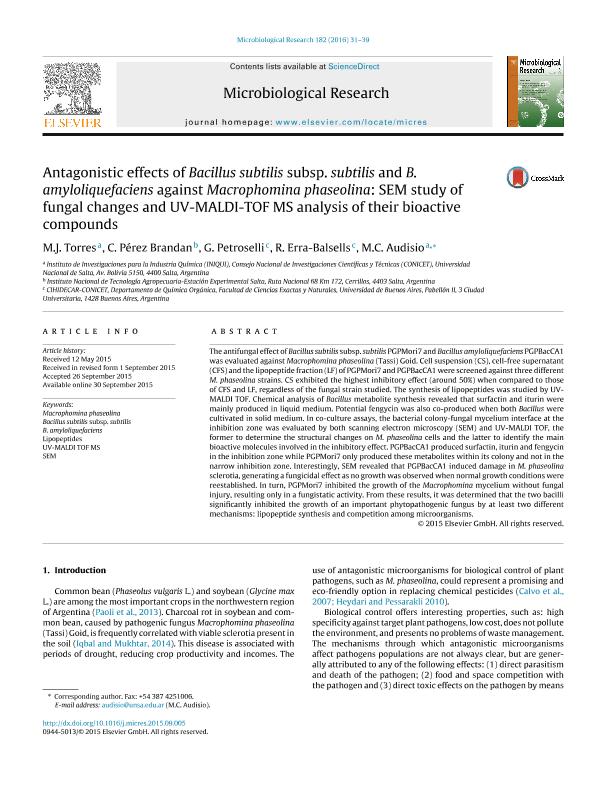Artículo
Antagonistic effects of Bacillus subtilis subsp. subtilis and B. amyloliquefaciens against Macrophomina phaseolina: SEM study of fungal changes and UV-MALDI-TOF MS analysis of their bioactive compounds
Torres, María Julia ; Perez Brandan, Carolina Gabriela; Petroselli, Gabriela
; Perez Brandan, Carolina Gabriela; Petroselli, Gabriela ; Erra Balsells, Rosa
; Erra Balsells, Rosa ; Audisio, Marcela Carina
; Audisio, Marcela Carina
 ; Perez Brandan, Carolina Gabriela; Petroselli, Gabriela
; Perez Brandan, Carolina Gabriela; Petroselli, Gabriela ; Erra Balsells, Rosa
; Erra Balsells, Rosa ; Audisio, Marcela Carina
; Audisio, Marcela Carina
Fecha de publicación:
01/2016
Editorial:
Elsevier Gmbh
Revista:
Microbiological Research
ISSN:
0944-5013
Idioma:
Inglés
Tipo de recurso:
Artículo publicado
Clasificación temática:
Resumen
The antifungal effect of Bacillus subtilis subsp. subtilis PGPMori7 and Bacillus amyloliquefaciens PGPBacCA1 was evaluated against Macrophomina phaseolina (Tassi) Goid. Cell suspension (CS), cell-free supernatant (CFS) and the lipopeptide fraction (LF) of PGPMori7 and PGPBacCA1 were screened against three different M. phaseolina strains. CS exhibited the highest inhibitory effect (around 50%) when compared to those of CFS and LF, regardless of the fungal strain studied. The synthesis of lipopeptides was studied by UV-MALDI TOF. Chemical analysis of Bacillus metabolite synthesis revealed that surfactin and iturin were mainly produced in liquid medium. Potential fengycin was also co-produced when both Bacillus were cultivated in solid medium. In co-culture assays, the bacterial colony-fungal mycelium interface at the inhibition zone was evaluated by both scanning electron microscopy (SEM) and UV-MALDI TOF, the former to determine the structural changes on M. phaseolina cells and the latter to identify the main bioactive molecules involved in the inhibitory effect. PGPBacCA1 produced surfactin, iturin and fengycin in the inhibition zone while PGPMori7 only produced these metabolites within its colony and not in the narrow inhibition zone. Interestingly, SEM revealed that PGPBacCA1 induced damage in M. phaseolina sclerotia, generating a fungicidal effect as no growth was observed when normal growth conditions were reestablished. In turn, PGPMori7 inhibited the growth of the Macrophomina mycelium without fungal injury, resulting only in a fungistatic activity. From these results, it was determined that the two bacilli significantly inhibited the growth of an important phytopathogenic fungus by at least two different mechanisms: lipopeptide synthesis and competition among microorganisms.
Archivos asociados
Licencia
Identificadores
Colecciones
Articulos(CIHIDECAR)
Articulos de CENTRO DE INVESTIGACIONES EN HIDRATOS DE CARBONO
Articulos de CENTRO DE INVESTIGACIONES EN HIDRATOS DE CARBONO
Articulos(INIQUI)
Articulos de INST.DE INVEST.PARA LA INDUSTRIA QUIMICA (I)
Articulos de INST.DE INVEST.PARA LA INDUSTRIA QUIMICA (I)
Citación
Torres, María Julia; Perez Brandan, Carolina Gabriela; Petroselli, Gabriela; Erra Balsells, Rosa; Audisio, Marcela Carina; Antagonistic effects of Bacillus subtilis subsp. subtilis and B. amyloliquefaciens against Macrophomina phaseolina: SEM study of fungal changes and UV-MALDI-TOF MS analysis of their bioactive compounds; Elsevier Gmbh; Microbiological Research; 182; 1-2016; 31-39
Compartir
Altmétricas



